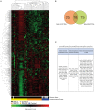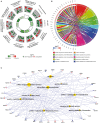Molecular Taxonomy of Sporadic Amyotrophic Lateral Sclerosis Using Disease-Associated Genes
- PMID: 28469596
- PMCID: PMC5395696
- DOI: 10.3389/fneur.2017.00152
Molecular Taxonomy of Sporadic Amyotrophic Lateral Sclerosis Using Disease-Associated Genes
Abstract
Amyotrophic lateral sclerosis (ALS) is a fatal neurodegenerative disease characterized by selective loss of upper and lower motor neurons. Despite intensive research, the origin and progression of ALS remain largely unknown, suggesting that the traditional clinical diagnosis and treatment strategies might not be adequate to completely capture the molecular complexity underlying the disease. In our previous work, comprehensive genomic profiling of 41 motor cortex samples enabled to discriminate control from sporadic ALS patients and segregated these latter into two distinct subgroups, each associated with different deregulated genes and pathways. Interestingly, some deregulated genes in sporadic ALS were previously associated with familiar ALS, indicating shared pathogenic mechanisms between the two forms of disease. In this, we performed cluster analysis on the same whole-genome expression profiles using a restricted (203) subset of genes extensively implicated in monogenic forms of ALS. Surprisingly, this short and unbiased gene list was sufficiently representative to allow the accurate separation of SALS patients from controls and the stratification of SALS patients into two molecularly distinct subgroups. Overall, our findings support the existence of a molecular taxonomy for ALS and represent a further step toward the establishment of a molecular-based diagnosis and patient-tailored therapies.
Keywords: amyotrophic lateral sclerosis; expression profiling; gene ontology analysis; genomics; molecular classification of disease subtypes.
Figures



Similar articles
-
Integrative multi-omic analysis identifies new drivers and pathways in molecularly distinct subtypes of ALS.Sci Rep. 2019 Jul 10;9(1):9968. doi: 10.1038/s41598-019-46355-w. Sci Rep. 2019. PMID: 31292500 Free PMC article.
-
Molecular classification of amyotrophic lateral sclerosis by unsupervised clustering of gene expression in motor cortex.Neurobiol Dis. 2015 Feb;74:359-76. doi: 10.1016/j.nbd.2014.12.002. Epub 2014 Dec 10. Neurobiol Dis. 2015. PMID: 25500340
-
Pathways and genes differentially expressed in the motor cortex of patients with sporadic amyotrophic lateral sclerosis.BMC Genomics. 2007 Jan 23;8:26. doi: 10.1186/1471-2164-8-26. BMC Genomics. 2007. PMID: 17244347 Free PMC article.
-
Transcriptional analysis reveals distinct subtypes in amyotrophic lateral sclerosis: implications for personalized therapy.Future Med Chem. 2015;7(10):1335-59. doi: 10.4155/fmc.15.60. Future Med Chem. 2015. PMID: 26144267 Review.
-
Selection of Potential Pharmacological Targets in ALS Based on Whole- Genome Expression Profiling.Curr Med Chem. 2015;22(17):2004-21. doi: 10.2174/0929867322666150408112135. Curr Med Chem. 2015. PMID: 25850769 Review.
Cited by
-
The Advent of Omics Sciences in Clinical Trials of Motor Neuron Diseases.J Pers Med. 2022 May 7;12(5):758. doi: 10.3390/jpm12050758. J Pers Med. 2022. PMID: 35629180 Free PMC article. Review.
-
Taxonomy Meets Neurology, the Case of Amyotrophic Lateral Sclerosis.Front Neurosci. 2018 Sep 26;12:673. doi: 10.3389/fnins.2018.00673. eCollection 2018. Front Neurosci. 2018. PMID: 30319346 Free PMC article.
-
Unsupervised machine learning identifies distinct ALS molecular subtypes in post-mortem motor cortex and blood expression data.Acta Neuropathol Commun. 2023 Dec 21;11(1):208. doi: 10.1186/s40478-023-01686-8. Acta Neuropathol Commun. 2023. PMID: 38129934 Free PMC article.
-
Integrative multi-omic analysis identifies new drivers and pathways in molecularly distinct subtypes of ALS.Sci Rep. 2019 Jul 10;9(1):9968. doi: 10.1038/s41598-019-46355-w. Sci Rep. 2019. PMID: 31292500 Free PMC article.
-
A Diagnostic Gene-Expression Signature in Fibroblasts of Amyotrophic Lateral Sclerosis.Cells. 2023 Jul 18;12(14):1884. doi: 10.3390/cells12141884. Cells. 2023. PMID: 37508548 Free PMC article.
References
-
- Ravits J, Appel S, Baloh RH, Barohn R, Brooks BR, Elman L, et al. Deciphering amyotrophic lateral sclerosis: what phenotype, neuropathology and genetics are telling us about pathogenesis. Amyotroph Lateral Scler Frontotemporal Degener (2013) 14(Suppl 1):5–18.10.3109/21678421.2013.778548 - DOI - PMC - PubMed
LinkOut - more resources
Full Text Sources
Other Literature Sources
Miscellaneous

